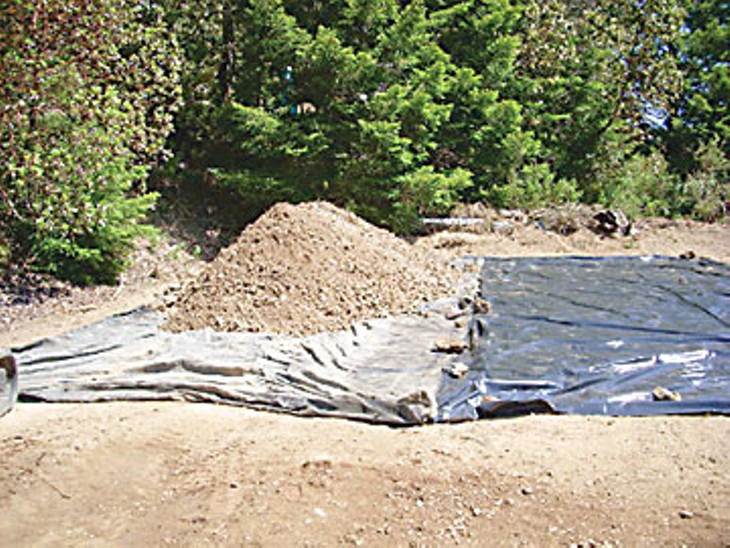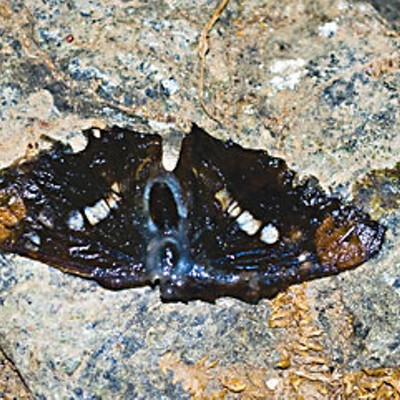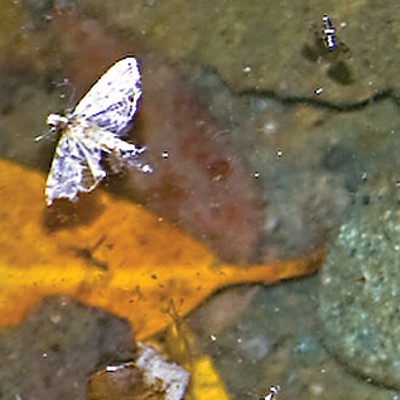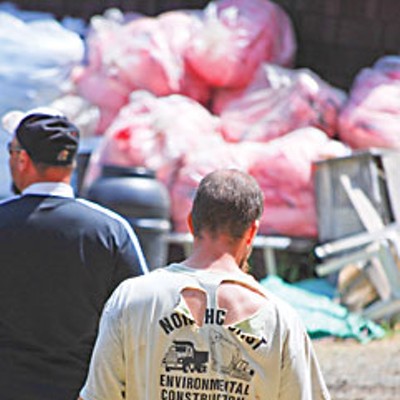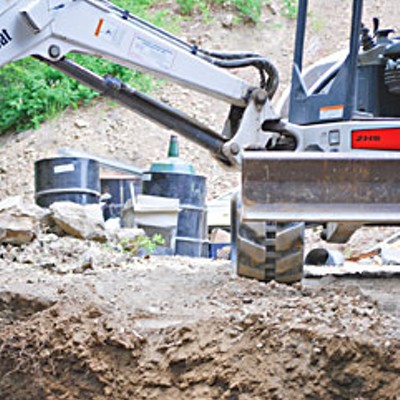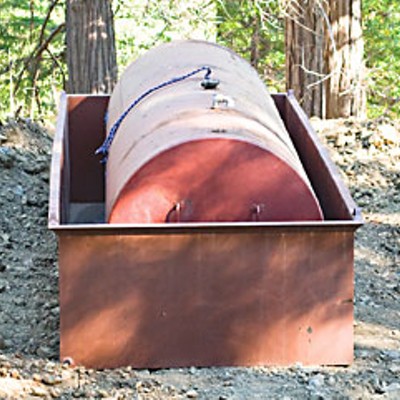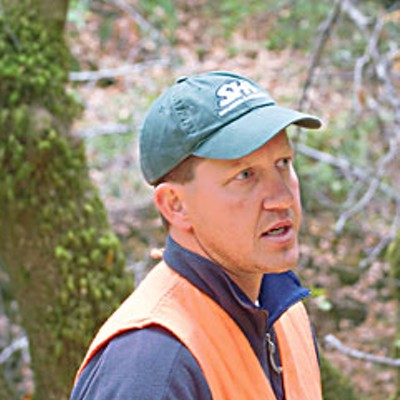After Hacker Creek
As harvest time comes to the hills, residents grapple with the consequences of diesel-fueled dope
By Kym Kemp[
{
"name": "Top Stories Video Pair",
"insertPoint": "7",
"component": "17087298",
"parentWrapperClass": "fdn-ads-inline-content-block",
"requiredCountToDisplay": "1"
}
]
Here, the air above the creek bed hums with the murmur of bees. The tock-tock of dripping liquid sounds like the faint ticking of a clock. This late in the year, the water barely creeps over the rocks but the air is sweet and warm. A small shallow pool between large stones cups two foothill yellow-legged frogs and the larva of a Pacific giant salamander. Startled under a rock by the presence of humans, the small bronze creature later creeps out onto the pool bottom. Opening a feathery fringe of deep purple gills, it filters oxygen from the surrounding still water.
Forty feet further down the nearly dry stream bed, the larva wouldn't survive. In spite of a massive $200,000 cleanup, Hacker Creek has yet to fully recover from a diesel spill which occurred four months ago at the site of an allegedly illegal indoor marijuana grow.
Below, where the estimated 600-1,000 gallon leak occurred, a pool of water suffocates under a film of oily diesel. Small dead and dying insects cover the surface. The same is true for most of the scant water nearby. In the hundreds of yards below the spill, hiking the stream bed yields only a few flying insects, a snake, a tiny tree frog and a larger, unhealthy looking frog. Conspicuously absent is the pleasant drone of bees and conspicuously present is the stench of fuel.
Before the spill, community activists were already struggling to address increasing concerns about the environmental damage caused by diesel-powered indoor marijuana grows. Dismaying stories were exchanged. One, originating with Mendocino County Sheriff Tom Allman, described how a grower poured large amounts of waste motor oil from his generator into "a redwood septic system -- a system designed to leach into the ground. And this system was only 100 yards from the Eel River."
Before the activists had time to do more than share their concerns with each other, a trail of white official vehicles wound like smoke up through the hills above Salmon Creek. And, like smoke, the cars were an indication that disaster had struck -- a fuel spill had spread diesel, leaving a blackened zone of slowly suffocating biosphere behind.
On May 14, an anonymous caller informed the Department of Fish and Game that he had "observed 20 to 30 pools of red diesel" in Hacker Creek. Though the caller was "unable to go in further due to possible respiratory problems," he was able to provide the agency with enough information that they were able to find the property by May 16.
Authorities quickly determined the source of the spill was an indoor marijuana grow powered by a diesel generator. Lt. John Wilcox of the California Dept of Fish and Game was among the first responders. He found two diesel tanks -- a large, 1,000 gallon storage tank used to fill a smaller one. Whether carelessly or through mechanical malfunction, the larger tank's fuel drained completely into the other tank. Of course, the lesser container overflowed.
"We don't know how much fuel was in either tank when the problem occurred," Wilcox explained. However, he emphasized, "there [was] a lot of fuel on the ground." The spill occurred on a rocky hillside, full of what the lieutenant called, "fractured shale." On this kind of ground, anything liquid quickly drains into the cracks. And unfortunately, the tanks were set up almost directly over a tributary of one of Southern Humboldt's larger streams -- Salmon Creek. Thus, the diesel swiftly made its way the 60 feet or so into the water of Hacker Creek, below. Downstream landowners were advised to pull their intake pipes and not use water from the creek. Originally, this prohibition reached partway into Salmon Creek itself, but eventually was restricted to Hacker Creek proper.
Before the spill, the creek plunged beneath lush spring growth. Small waterfalls splashed onto moss-lined rocks. The area harbored a variety of wild creatures and plants. Critically endangered California bunchgrass gathered like herds of deer on the banks above the water. Capable of living up to 200 years, some of these plants put up shoots before the first white settler came to the area. Wild strawberries bloomed, promising sweet fruit later in the year.
Translucent pools offered habitat for frogs, salamanders, invertebrates and other creatures. Further down, Hacker Creek provided an important summer rearing ground for juvenile steelhead and "probably nesting areas also," said Kyle Keegan, a local resident who has worked on several surveys of the area for the U.S. Fish and Wildlife Service in conjunction with the California Dept. of Fish and Game.
As the spill oozed into this lovely area, a greasy film asphyxiated any still water. Diesel smell permeated the creek bed. Though no frogs or salamanders were found dead in the area, many insects were. "Invertebrates are dying," pointed out Larry Lancaster, Hazmat inspector for the county, at the time. "That means the food supply [for amphibians, etc.] is being diminished."
In an effort to save the area, a contractor specializing in diesel cleanup rushed to the scene. Within days, three semi-trucks full of absorbent pads navigated the twisting narrow dirt passage, miles from the end of the county road. Through temperatures reaching into the hundreds, Northcoast Environmental Construction worked to clean up the mess. They removed fuel tanks, tore down a structure, laid absorbent materials, cut roads with cats and dug up soil. They quickly recovered about 300 gallons of the spilled fuel, but it took almost two months to complete the cleanup to the satisfaction of an inspector.
Meanwhile, costs piled up. The owner of the property, Albert Tordjman, a popular Bay Area chef and former owner of the critically acclaimed Flying Saucer restaurant, is responsible for paying them all. According to his lawyer, Eric Kirk, Tordjman declared he had been away in Thailand. His two tenants living on the land operated an illegal marijuana operation without his knowledge. A few days before the spill, when the chef came back from his trip abroad, he was unable to contact his tenants so he drove to the site. "He had no idea what was happening before he reached the property," Kirk said.
According to neighbors, once Tordjman arrived at his home, authorities handcuffed and interrogated the older man before releasing him. Later, Tordjman became ill and had to be rushed to the hospital. His lawyer says that the former chef is "under enormous stress." The property, known as the Red Gypsy Ranch, is now for sale -- purportedly to pay the nearly $215,000 in fines assessed, as well as the costs of the cleanup. The amount owed to the county for fines has actually been reduced from $505,600. If Tordjman doesn't meet his payment schedule, then he is liable for the full penalty of over half a million dollars. Kirk explains that his client might have to file for bankruptcy and, in any case, "he will probably spend the rest of his life in poverty."
When asked if the fines are not unusually heavy, Melissa Martel of the Division of Environmental Health at the Humboldt County Dept. of Health and Human Services explains that her agency wants to see this kind of activity stopped. The agency hopes that the fine brings attention to the "chemical releases associated with marijuana grows," and that all diesel users, whether associated with grows or not, will "make a small investment in infrastructure" so that spills can be contained. Martel says that the Hacker Creek fines are high because such a large spill in an active waterway makes the harm to the public greater than in other cases.
In spite of the large amounts involved, the fines in such cases can be the least of a grower's problems. While investigating a diesel spill in the Piercy area back in 2005, a Dept. of Fish and Game officer discovered Cody Dobbs in a grow room associated with the fuel mess leaked from three water tanks filled with diesel. Convicted of growing over 10,000 marijuana plants in Humboldt and Mendocino Counties, Dobbs faced a minimum of 10 years to a maximum of life in prison.
The perception among many is that environmental damage will increase sentences for marijuana crimes. As an anonymous commenter on the Times-Standard's May 23, 2008, online edition explains about Dobbs' 10-year sentence, "In reality he's not going to the can for growing weed but for polluting a stream."
Indoor growers are taking note of this trend and adjusting their practices. An elderly retired couple from a community near Garberville spent this summer upgrading their fuel system. Used to supply their diesel generator, it powers their indoor grow scene. They installed both a large feeder tank with containment and a double-walled fuel tank which has special shutoff valves designed to instantly halt the diesel flow when the generator stops for any reason. "I might forget to shut the valve off," "Max" explains. [Ed. note: The names and a few identifying characteristics of "Max" and other non-convicted marijuana growers in this story have been changed.]
Tapping the front of his walker which Max uses whenever he leaves home, he grins ruefully. "I'm old," he says. "Besides, cops cut your lines when they bust and blame you for a spill." He believes the new valve system will make it harder for this to happen.
Law enforcement severing fuel lines and blaming the resulting mess on the grower is frequently cited by diesel proponents as the reason so many busts have spills associated with them. Earlier this year, Mendocino County Sheriff Tom Allman vehemently denied these allegations, but growers continue to claim they happen -- though most of the cases cited are over 10 years old.
Both Max and his wife are retired professionals in their seventies, but medical bills eat up a large part of their income. He farms indoors to make ends meet. "I can't live on outdoor," he says. Unspoken -- because he believes it is obvious -- is the belief that without some form of marijuana income, he would be unable to pay the bills at all. "Last year is the first year I felt confident enough to grow outside," he says. Bracing himself painfully on his walker, he waves his other hand out over his lush vegetable garden, where several medium-sized marijuana plants mingle with arugula, tomatoes, corn and other vegetables. "They haven't been here in years," he says, meaning the Campaign Against Marijuana Planting (CAMP).
Although he has a few outdoor plants, the majority of Max's income results from his indoor crop. He is worried because the costs continue to increase. In order to fill his large diesel tank, he must drag $5,000 from his pockets and hand it to a fuel company. Then he lays out $3,000 for clones (smaller plants taken from a large mother plant and thus guaranteed to be females of the same desirable strain) and $1,000 for dirt and other amendments. Max farms his marijuana organically, both indoor and outdoor, but he is the exception in an industry rife with chemicals designed to rid grow rooms of spider mites, powdery mildew and other problems. Thus, he must also pay for ladybugs and other natural merchandise to keep his product healthy.
Furthermore, though he used to produce a pound of marijuana per light, the most recent fad is for a purple strain that is difficult to raise. "I think the buyers sit around and come up with the worst possible plant, with the least yield and the hardest to grow," he complains. Now he is only able to get a half a pound per light and his profits are down.
Even before the Hacker Creek spill, though, Max worried about more than his profits. "I've never been a bad guy before," he says as he contemplates information about how diesel affects the environment. He worries about how his neighbors perceive him. "The worse thing is, everything they say, I can't argue with." Concerned with health and environmental issues much of his life, Max finds his reliance on growing indoor marijuana at odds with his ideals.
Max's individual plight echoes through the community around him. Many people moved here to live closer to the Earth. They began growing a little marijuana-- first for private use and, eventually, to supplement their incomes. Then CAMP began a huge push in the late ’80s and much of the ’90s. Many growers moved indoors to hide their activities from law enforcement without considering possible environmental side effects. As indoor marijuana production rose and buyers began to prefer the consistency and intensity, outdoor marijuana became a sad second -- worth about half its hothouse-raised cousin.
In spite of concerns about the environment, the rising costs, and increased pressure from mounting fines and prison sentences, Max doesn't want to give up his indoor grow. He and his wife use it medicinally, and he needs the income. Concerns about the environment worry him the most. Nevertheless, he still believes that indoor marijuana reduces his environmental footprint better than conventional drugs. "You know, Vicodin comes shipped in a boat all the way from China. It's medicine. But, we're making organic medicine locally."
Many in the community are less sanguine though. A group of Salmon Creek residents were already meeting to discuss the effects of diesel farming on the environment when the Hacker Creek spill occurred. The movement soon spread to the greater Southern Humboldt Community. When 40 to 50 locals met in Garberville's largest gathering space, the local community-run radio station, KMUD, devoted a call-in show the next morning to the subject and both the local newspapers carried stories.
Hardy Church, one of the founders of the anti-diesel movement, claims Northern California's economic interconnection with diesel-powered grow scenes is unhealthy. "It makes some people richer but it makes people in the watersheds poorer because of the adverse health effects." He believes that "neighbors around here seem to be locked into a bad habit ... Moms and Pops are struggling to sell beautiful organic non-polluting pot because diesel dopers are inundating the market with crap." Church worries not only about fuel spills but about the damage large diesel trucks do to fragile dirt roads. "There are no taxes coming from [large fuel companies] to pay for the dirt roads." Dirt roads in rural hills are maintained by the users, but he believes that fuel trucks do more damage than the diesel users pay for.
He also expressed concern about improperly wired grow rooms catching fire, especially during the summer season. "The fire danger scares the shit out of me," he says. "I'm expending more energy trying to prepare my curtilage for accidents ... I had to rescue my neighbor when his truck and two tanks of diesel were about to roll down the hill and into the water." According to Church, the cost of growing indoors is borne by the community while the grower reaps the profits and the land is "raped."
For the neighbors of the Hacker Creek spill, the effects are personal -- their property has been devalued, their lives disrupted and their loyalties to their community torn. Barbara King and her son, Julian, recently hiked from their home up the waterway to the spill site.
Barbara knows and loves the local flora and fauna. While moving up the creek bed, she points out uncommon shrub species, quietly watches a small snake slither over a large rock, and gently fingers ferns, letting soft yellow powder cover her fingertips as she indicates unusual pollination patterns. However, she quiets when approaching the damaged area. Gazing at the diesel glazed pools covered with dead and dying insects, Barbara shakes her head and whispers, "I'm a bit disappointed, really." Then gathering herself, she adds with asperity, "It's really shocking and it stinks!" It's not only the diesel that distresses her; she points out waterline and pieces of asbestos thrown into the creek. "What to do about it? I'm so perplexed."
Recently she spoke with someone contemplating buying the spill property. Worried that another indoor operation might start up again, "I reminded him that he is at the top of the creek and everybody else is at the bottom." After all, this is not the first spill at this site. One happened there about 12 years ago, too, and there are rumors of a third.
"I don't like to go off on people," she says, then adds with a sigh, "You hear generators as you walk along the road ... I'm more or less shutting my eyes. [I] feel this dread and anger ..." She doesn't want to accuse her neighbors without cause. But, she worries, "I basically don't say enough."
On another day in late September, Erik Nielsen of SHN Consulting Engineers stared down at pools covered by diesel. "Because there is such a low flow, things aren't going anywhere ... In some ways that is a good thing. As a natural occurrence, sun breaks down the residual stuff on the rocks ... Overall, effects aren't as bad as July," he said. He explains, with hope, rain washing through the spill area will flush the pollutants more extensively. The diesel no longer stings the eyes -- much of it has been carted off, embedded in soil to be rehabilitated.
The economic fallout of dismantling the indoor grows could be devastating both to individuals and to the County as a whole. But the ecological fallout is long lasting and so are the reverberations throughout Humboldt County. The tock, tock of dripping water in Hacker Creek, like the ticking of a clock, warns community activists that time for solving the environmental and social consequences of indoor marijuana is running out, and another ecological disaster could explode.
Generating waste
Generators require regular oil changes. While the exact figures for the generators on the Mendocino County site were unavailable, the machines probably had an oil capacity of around eight gallons each. Many manufacturers recommend changing the lubricant after a certain amount of use -- in this case probably every five days. Between the two generators found on the site, that is about 240 gallons of oil a month, or a conservative guess of 600 gallons per growing cycle.
Thus, for every cycle the growers completed, 600 gallonsof hazardous waste oil was dumped near the Eel River.
According to the Environmental Protection Agency, "Just one gallon of used oil has the potential for contaminating one million gallons of drinking water." Thus one growing cycle could contaminate up to 600 million gallons of water (which, according to a 2006 newsletter, is roughly 100 million more gallons than Fortuna uses in an entire year.)
My kinda diesel
Transportation diesel: Sold in the gas station for cars.
Off-road or "red" diesel: So-called because it is dyed to allow law enforcement to differentiate it from that used on roads. Taxes aren't charged upon sale of it. Sold for agricultural uses, most indoor grows are powered by it.
Biodiesel: Usually the most expensive of all, and made from soybean oil and waste food oils such as that used to fry foods. There are blends that combine biodiesel with regular car diesel in differing amounts. In fact, most biodiesel is a blend. Some marijuana grows use biodiesel, but many growers claim it "gums" up the generators.
Harsh reality
A large percentage of the pot being grown in sunny California is not being grown in the sun at all
The stagnant controlled environment of an indoor scene creates the perfect breeding ground for spider mites, powdery mildew and other pests. Smoking indoor pot often means inhaling the residues of pesticides, fungicides and chemical fertilizers widely used in the commercial rowing process and may pose a serious risk to your health.
Diesel spills both large and small caused by indoor grows have contaminated rivers, streams, and drinking water sources in several communities here in Northern California.
According to authorities, the highest percentage of fires in rural wildlands in Mendocino and Humboldt Counties are caused from indoor grows which have increased the risk of catastrophic wildfires during dry summer months
Diesel exhaust contains over 450 chemicals; 40 are listed by California and the US. Environmental Protection Agency (EPA) as toxic air contaminants and carcinogens.
Diesel particulates are the most significant source of air toxins in California and account for 70 percent of the cancer risk from toxic air contaminants.
Growing 1.75 lb. of indoor pot with a diesel generator produces over 3,000 lbs of CO2!
A 20-light indoor diesel grow scene uses approximately 1,500 gallons of diesel per 75 day cycle.
Source: Flyer from 'Communities Addressing Pot Pollution,' an anti-diesel group.
Comments (11)
Showing 1-11 of 11
more from the author
-
UPDATE: Coast Guard Rescues Crab Boat Crew
- Jan 25, 2021
-
U.S. Coast Guard Rescues Distressed Fishermen
- Jan 17, 2021
-
UPDATE: Fortuna High on Lockdown Due to Armed Person Nearby
- Jan 11, 2021
- More »
Latest in News
Readers also liked…
-
Through Mark Larson's Lens
A local photographer's favorite images of 2022 in Humboldt
- Jan 5, 2023
-
'To Celebrate Our Sovereignty'
Yurok Tribe to host gathering honoring 'ultimate river warrior' on the anniversary of the U.S. Supreme Court ruling that changed everything
- Jun 8, 2023
